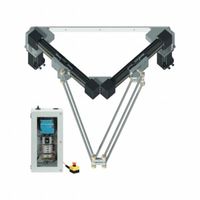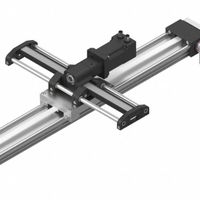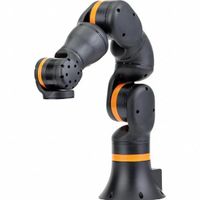Call +(254) 703 030 000 / 751 483 999 / 721 704 777
.....Read More
Frequently Asked Questions
What are the different types of robotics equipment used in automation?
In automation, various types of robotics equipment are utilized to enhance efficiency, precision, and productivity across industries. These include:
1. **Articulated Robots**: Featuring rotary joints, these robots are highly versatile and commonly used in manufacturing for tasks like welding, painting, and assembly.
2. **SCARA Robots (Selective Compliance Articulated Robot Arm)**: Known for their speed and precision, SCARA robots are ideal for pick-and-place tasks, assembly operations, and packaging.
3. **Delta Robots**: With a spider-like design, delta robots are used for high-speed, precise operations such as sorting, packaging, and assembly in the food and pharmaceutical industries.
4. **Cartesian Robots (Gantry Robots)**: Operating on three linear axes (X, Y, Z), these robots are used for CNC machines, 3D printing, and pick-and-place applications due to their accuracy and repeatability.
5. **Collaborative Robots (Cobots)**: Designed to work alongside humans, cobots are equipped with sensors and safety features, making them suitable for tasks like assembly, quality inspection, and machine tending.
6. **AGVs (Automated Guided Vehicles)**: Used for material handling, AGVs transport goods within warehouses and factories, following predefined paths using sensors and navigation systems.
7. **AMRs (Autonomous Mobile Robots)**: Unlike AGVs, AMRs navigate dynamically using onboard sensors and maps, making them flexible for logistics and warehousing tasks.
8. **Robotic Arms**: These are used in various applications, from simple pick-and-place tasks to complex assembly and machining operations, offering precision and strength.
9. **Drones**: Employed for aerial inspections, surveillance, and delivery, drones are increasingly used in agriculture, logistics, and infrastructure monitoring.
10. **Humanoid Robots**: Designed to mimic human actions, these robots are used in research, customer service, and entertainment, offering interaction capabilities.
Each type of robotics equipment is tailored to specific tasks, enhancing automation by improving speed, accuracy, and safety in industrial processes.
How do robotic arms mimic human arm movements?
Robotic arms mimic human arm movements through a combination of mechanical design, sensors, actuators, and control algorithms. The mechanical structure of a robotic arm is designed to replicate the human arm's anatomy, typically consisting of segments that correspond to the upper arm, forearm, and hand. These segments are connected by joints that mimic the shoulder, elbow, and wrist, allowing for a range of motion similar to that of a human arm.
Sensors play a crucial role in mimicking human movements. They provide feedback on the position, speed, and force of the robotic arm, enabling precise control. Common sensors include encoders for position feedback, accelerometers for motion detection, and force sensors for tactile feedback. These sensors help the robotic arm understand its environment and adjust its movements accordingly.
Actuators, such as electric motors, hydraulic systems, or pneumatic systems, drive the movement of the robotic arm. These actuators are controlled by algorithms that translate human-like movements into mechanical actions. The control algorithms are often based on kinematics and dynamics, which calculate the necessary joint angles and forces to achieve a desired position or trajectory.
Advanced robotic arms use machine learning and artificial intelligence to improve their ability to mimic human movements. By analyzing data from sensors and learning from human demonstrations, these systems can adapt to new tasks and environments, enhancing their flexibility and precision.
In some cases, robotic arms are directly controlled by human operators through teleoperation or exoskeletons, where the operator's movements are directly translated to the robotic arm. This allows for intuitive control and can be used in applications where human-like dexterity is required.
Overall, the combination of mechanical design, sensors, actuators, and intelligent control systems enables robotic arms to effectively mimic human arm movements.
What are the benefits of using multiaxis gantries in automation?
Multiaxis gantries offer several benefits in automation, enhancing efficiency, precision, and flexibility in various industrial applications.
1. **Increased Flexibility**: Multiaxis gantries can move in multiple directions, allowing for complex and precise positioning of tools or workpieces. This flexibility supports a wide range of tasks, from simple pick-and-place operations to intricate machining processes.
2. **Enhanced Precision and Accuracy**: These systems provide high levels of precision and repeatability, essential for applications requiring exact positioning. The ability to control movement along multiple axes ensures that tasks are performed with minimal error.
3. **Improved Throughput**: By automating tasks that would otherwise require manual intervention, multiaxis gantries can significantly increase production speed. Their ability to handle multiple tasks simultaneously or in quick succession reduces cycle times and boosts overall throughput.
4. **Space Efficiency**: Multiaxis gantries can be designed to fit into existing production lines without requiring significant space. Their ability to operate in three-dimensional space allows for efficient use of available area, optimizing the layout of manufacturing facilities.
5. **Versatility**: These systems can be adapted for various applications, from assembly and packaging to welding and inspection. Their modular design allows for easy integration with other automation technologies, enhancing their utility across different industries.
6. **Reduced Labor Costs**: By automating repetitive and labor-intensive tasks, multiaxis gantries reduce the need for manual labor, leading to cost savings. This also allows human workers to focus on more complex and value-added activities.
7. **Scalability**: Multiaxis gantries can be scaled to meet the demands of different production volumes. Their modular nature allows for easy expansion or reconfiguration as production needs change.
8. **Improved Safety**: Automation with multiaxis gantries reduces the risk of workplace injuries by minimizing human interaction with potentially hazardous tasks or environments.
How do delta robots function and what are their applications?
Delta robots function using a parallel-arm mechanism, typically consisting of three arms connected to universal joints at the base. These arms are connected to a small, triangular platform that holds the end effector. The arms are driven by motors located at the base, which allows for rapid and precise movements. The design enables the delta robot to achieve high-speed operations with low inertia, making it ideal for tasks requiring quick and accurate positioning.
The kinematics of delta robots allow them to move in three translational degrees of freedom (X, Y, Z) and sometimes rotational movements, depending on the design. The parallel structure provides rigidity and stability, allowing for high precision and repeatability. The lightweight arms and centralized motors contribute to the robot's ability to perform high-speed pick-and-place tasks.
Applications of delta robots are diverse, primarily in industries where speed and precision are critical. In the food industry, they are used for sorting, packaging, and handling delicate items like chocolates or pastries. In the pharmaceutical sector, delta robots assist in the packaging and assembly of medical devices and medications. The electronics industry employs them for assembling small components and circuit boards. Additionally, delta robots are used in 3D printing, where their precision and speed enhance the additive manufacturing process.
Overall, delta robots are valued for their efficiency, speed, and accuracy, making them suitable for various high-speed automation tasks across multiple industries.
What role do robot control components play in automation systems?
Robot control components are crucial in automation systems as they serve as the brain and nervous system, orchestrating the actions and responses of robotic mechanisms. These components include controllers, sensors, actuators, and software algorithms, each playing a vital role in ensuring precise and efficient operation.
Controllers are the central processing units that interpret input data, execute control algorithms, and send commands to actuators. They manage the robot's movements, ensuring tasks are performed accurately and efficiently. Advanced controllers can handle complex computations, enabling robots to perform intricate tasks and adapt to dynamic environments.
Sensors provide real-time data about the robot's surroundings and its own state. They include vision systems, proximity sensors, and force sensors, among others. This sensory feedback is essential for the robot to interact safely and effectively with its environment, allowing for adjustments in real-time to avoid obstacles or correct errors.
Actuators are the components that convert control signals into physical movement. They include motors, hydraulic systems, and pneumatic devices, which drive the robot's joints and end-effectors. The precision and responsiveness of actuators are critical for executing tasks with the required speed and accuracy.
Software algorithms are the decision-making frameworks that process sensor data and determine the appropriate actions. These algorithms range from simple control loops to complex artificial intelligence systems that enable learning and adaptation. They ensure that robots can perform tasks autonomously, optimize performance, and handle unexpected situations.
Together, these control components enable automation systems to perform repetitive, hazardous, or precision tasks with high efficiency and reliability. They enhance productivity, reduce human error, and allow for the deployment of robots in diverse industries, from manufacturing and logistics to healthcare and service sectors.
How can robotic equipment be integrated into existing systems?
Integrating robotic equipment into existing systems involves several key steps to ensure seamless operation and maximize efficiency. First, conduct a thorough assessment of the current system to identify areas where automation can add value. This involves analyzing workflows, identifying bottlenecks, and determining the specific tasks that can be automated.
Next, select the appropriate robotic technology that aligns with the identified needs. This could range from industrial robots for manufacturing processes to collaborative robots (cobots) for tasks requiring human-robot interaction. Ensure the chosen robots are compatible with existing equipment and software systems.
Develop a detailed integration plan that outlines the steps for installation, testing, and deployment. This plan should include timelines, resource allocation, and risk management strategies. Collaborate with stakeholders, including IT, operations, and engineering teams, to ensure all aspects of the integration are covered.
Implement necessary infrastructure upgrades, such as network enhancements and power supply adjustments, to support the new robotic systems. Integrate the robots with existing software systems, such as enterprise resource planning (ERP) or manufacturing execution systems (MES), to enable seamless data exchange and process coordination.
Conduct rigorous testing to ensure the robots function correctly within the existing system. This includes performance testing, safety checks, and validation of integration with other equipment. Address any issues that arise during testing to prevent disruptions during full-scale deployment.
Train employees on the operation and maintenance of the new robotic systems. This includes safety protocols, troubleshooting, and routine maintenance tasks. Encourage a culture of collaboration between human workers and robots to optimize productivity and innovation.
Finally, establish a continuous monitoring and improvement process to evaluate the performance of the integrated system. Use data analytics to identify areas for further optimization and ensure the system adapts to changing business needs.
What educational tools are available for learning about robotics automation?
There are numerous educational tools available for learning about robotics automation, catering to various skill levels and learning preferences. Online platforms like Coursera, edX, and Udacity offer comprehensive courses on robotics and automation, often in partnership with leading universities and tech companies. These courses cover fundamental concepts, programming, and practical applications.
For hands-on learning, robotics kits such as LEGO Mindstorms, VEX Robotics, and Arduino provide practical experience in building and programming robots. These kits are suitable for beginners and can be used in educational settings or at home. Raspberry Pi and micro:bit are also popular for DIY robotics projects, offering a platform to learn coding and electronics.
Simulation software like Gazebo, Webots, and V-REP allows learners to design and test robots in a virtual environment, which is particularly useful for understanding complex systems without the need for physical components. These tools often integrate with programming languages like Python and C++.
Books and textbooks, such as "Introduction to Robotics: Mechanics and Control" by John J. Craig and "Robotics: Modelling, Planning and Control" by Bruno Siciliano, provide in-depth theoretical knowledge and are essential for academic study.
Robotics competitions, such as FIRST Robotics and RoboCup, offer practical experience and foster teamwork and problem-solving skills. These competitions are available for various age groups and skill levels.
Finally, online communities and forums like Stack Overflow, Reddit, and specialized robotics forums provide a platform for learners to ask questions, share projects, and collaborate with others interested in robotics automation. These resources collectively offer a comprehensive approach to learning about robotics automation, combining theoretical knowledge with practical application.




